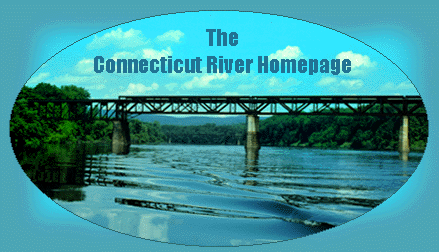 Using scuba gear, Ed and a team of colleagues,
undergraduate and graduate students have come upon what appear to
be an old dam, pieces of a train, the remains of a railroad trestle
thought to have been ripped from its moorings by the flood of 1936, and
remnants of the nation’s oldest canal built in 1792-95 near South Hadley.
They have recovered anchors and variously colored glass elixir bottles.
In August 1997, diving team members, grad students Monica O’Guinn and
Sean Werle, discovered a 120-foot-deep abyss. It was named King Philip’s
Abyss in homage to Metacomet, the Wampanoag Indian chief who fought to
drive English colonists from the Connecticut River Valley.
Using scuba gear, Ed and a team of colleagues,
undergraduate and graduate students have come upon what appear to
be an old dam, pieces of a train, the remains of a railroad trestle
thought to have been ripped from its moorings by the flood of 1936, and
remnants of the nation’s oldest canal built in 1792-95 near South Hadley.
They have recovered anchors and variously colored glass elixir bottles.
In August 1997, diving team members, grad students Monica O’Guinn and
Sean Werle, discovered a 120-foot-deep abyss. It was named King Philip’s
Abyss in homage to Metacomet, the Wampanoag Indian chief who fought to
drive English colonists from the Connecticut River Valley.
The underwater exploration of New England’s largest river has led to
the construction of a web site by Ed and project historian Libby Klekowski.
It offers much interesting information
about the biology, history and geology of the Connecticut River, URL:
www.bio.umass.edu/biology/conn.river/
 Denizens of
the river encountered by Ed and his divers include the yellow lampmussel,
Lampsilis cariosa, a freshwater clam thought to have
disappeared from the river 30 years ago, sponges the size of dinner
plates, flatworms, mussels, eels, wall-eyed pike, and an abundance of the
large green alga Chara as well as the bryozoan Pectinatella
magnifica, a primitive filter-feeding animal. Clay deposits at
the bottom of the river have yielded a new species of red bloodworm,
Axarus varvensis.
Denizens of
the river encountered by Ed and his divers include the yellow lampmussel,
Lampsilis cariosa, a freshwater clam thought to have
disappeared from the river 30 years ago, sponges the size of dinner
plates, flatworms, mussels, eels, wall-eyed pike, and an abundance of the
large green alga Chara as well as the bryozoan Pectinatella
magnifica, a primitive filter-feeding animal. Clay deposits at
the bottom of the river have yielded a new species of red bloodworm,
Axarus varvensis.
 On the bottom of the deepest parts of the river, Ed and his
team have come upon varves, large stratiform sediments of clay and silt that
were apparently formed when, with the waning of the most recent ice age, a
massive body of water known as Lake Hitchcock covered the area between
New Britain, CT and St. Johnsbury, VT.
On the bottom of the deepest parts of the river, Ed and his
team have come upon varves, large stratiform sediments of clay and silt that
were apparently formed when, with the waning of the most recent ice age, a
massive body of water known as Lake Hitchcock covered the area between
New Britain, CT and St. Johnsbury, VT.
Some of the artifacts reclaimed from the bottom of the
river are currently on display at the Springfield Science Museum.
The exhibit, entitled "The Underwater World of the Connecticut River",
features an eight-minute
videotape that focuses on the archaelogical, biological and historical
treasures of the river. The exhibit is the first collaborative effort between
the Springfield Science Museum and the University of Massachusetts, Amherst.
Another display documenting the underwater world of the Connecticut was
exhibited at the Connecticut River Museum in Essex, Connecticut last summer.